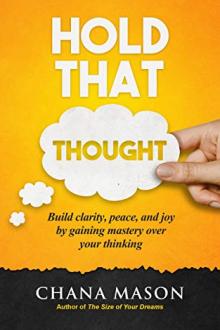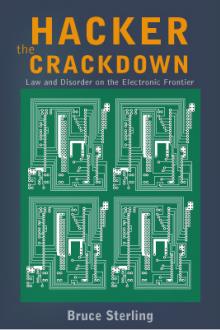Hold that Thought by - (the reader ebook TXT) 📖

- Author: -
- Performer: -
Book online «Hold that Thought by - (the reader ebook TXT) 📖». Author -
A tool for gathering overt or implied thoughts expressed by a speaker’s stream of consciousness.

As you think, so shall you be.
- Wayne Dyer
People often don’t know what exactly is blocking them from moving forward. They might not know how to identify their thinking or are scared of the thoughts swimming under the surface. This might lead to some very “blah” dialogues. Warning: if you try to work on a blah thought, you’ll get blah results. The Rant is an excellent tool for identifying the bigger issues beneath.
Jane walked into my office unable to settle down enough to sit. She teetered from one foot to the other as she answered my “How are you doing?” with, “I dunno.”
Chana: What do you mean when you say, “You don’t know?”
Jane: Just that, I feel upset, sort of. Well, not exactly upset… more like, frustrated.
Chana: So you’re frustrated. What about?
Jane: I don’t think frustrated is the word. It’s more like – uneasy.
Jane has a collection of emotions she’s struggling to identify, and she’s jumping from one to the next. We can keep playing pin the tail on the feeling or move on to what I consider to be a more useful exercise: pin the tail on the thoughts.
A core principle of Inquiry is that every emotion is triggered by a thought. For Jane, experiencing a collection of painful feelings means she’s believing a whole stew of painful thoughts. Recognizing these thoughts is the most useful next step:
Chana: What thoughts are causing you upset right now?
Jane: I’m not sure. I’m just annoyed at my sister. Something happened yesterday.
Jane doesn’t know on a conscious level what specific thoughts are causing her upset; rather there’s a whole story fueling her feelings, and that story has a slew of beliefs at its foundation. By hearing the story, I can use my outsider’s perspective to identify these thoughts and reflect them back to Jane.
I invited Jane to Rant and pulled out all the thoughts she overtly stated and the ones I could hear between the lines. Ranting gave Jane the opportunity to talk freely without having to filter her words or cognitively understand her every motive. You’ll see Jane’s story below. Cover the Thought Bank I formulated, and write down what thoughts you guess Jane believed as she told her story. (We’ll delve into the concept of a Thought Bank in a couple of chapters. For now, it’s enough for you to know it’s a collection of thoughts or beliefs.) Once you’ve done so, take a look at my collection.
Jane’s Story
Katlyn came to visit yesterday. The minute she walked in the door, she started picking up the kids’ toys and putting them in the toy chest. Then she walked into my kitchen and washed the dishes. She didn’t even ask me if I wanted her to do these things. It made me feel so uncomfortable - like she just thinks I’m a slob. We sat down for lunch, and while I was still telling her about Johnny’s fight with his baseball coach, she picked up the plates and took them into the kitchen. It’s like she’s my mom or something. She doesn’t think I can look after myself. Her kids are all grown, so now she has to mother me. It’s so embarrassing. Why can’t she just believe in me? She doesn’t even trust I can take care of my kids. She asked me if I wanted her to go to Johnny’s next ballgame instead of me. My face got so hot. Even after all these years, she just thinks I’m a baby.
Thought Bank
I don’t need help.
I should be able to do everything on my own.
My sister thinks I’m a mess.
She shouldn’t clean up without asking me.
Katlyn thinks I’m a slob.
I’m a slob.
My house is a mess.
I can’t take care of myself.
Katlyn thinks I can’t take care of myself.
Katlyn is nosy.
Katlyn thinks I’m a child.
I can’t take care of my kids.
Katlyn thinks I can’t take care of my kids.
I’m a baby.
I’m not capable.
Katlyn is insensitive.
Katlyn doesn’t trust me / believe in me.
Katlyn is ove rbearing.
When she finished telling her story, I read my list back to her. She let me know which thoughts felt true and which ones were irrelevant. I wanted to work on the most powerful of these so we could have the greatest impact during our session. The most disturbing beliefs are the ones that, when toppled, can shake up our perspective the most.
Chana: Which thought feels the most true and the most painful at the same time?
Jane: Katlyn thinks I’m a slob.
We processed Jane’s belief about her sister using The Work of Byron Katie. The Work is made up of four questions:
Is it true? Can you absolutely know that it’s true? How do you react when you believe the thought? Who/How would you be without the thought?We are then asked to identify as many turnarounds (opposites) of the thought as we can and offer at least three reasons why the new thought is as true or more true than the original one. In this Inquiry, you’ll see how I use The Work as a tool for facilitation.
Chana: Is it true that Katlyn thinks you’re a slob?
Jane: Yeah.
Chana: Can you absolutely know that it’s true?
Jane: Hmm… I guess I can’t know for sure.
Chana: And how do you react when you believe that Katlyn thinks you’re a slob?
Jane: I want to disappear. And at the same time, I want to yell at her.
Chana: Anything else?
Jane: My body gets hot and tense. I can’t enjoy my sister; I just want to avoid her when she comes over.
Chana: Now, take a deep breath and imagine yourself at home with your sister. She’s doing your dishes and the thought that Katlyn thinks you’re a slob isn’t there. How would you be without the thought?
Jane: Oh. That’s funny. I’d be relieved. I didn’t know how I was going to get through the dishes that day. My kitchen was all cleaned up by the time she was done, and it was so much easier for me to make dinner. Gosh. I don’t think I even said, “Thank you.”
Chana: Anything else?
Jane: Yes. I’d be more relaxed. Calmer. More open to talking and connecting to her.
Chana: So let’s turn it around. What’s the opposite of “Katlyn thinks you’re a slob?”
Jane: Katlyn doesn’t think I’m a slob.
Chana: Give me three reasons it’s as true or truer than your original belief.
Jane: She never said so. She had a smile on her face while she did the dishes.
Chana: One more.
Jane: Ha. I just thought of something… When her kids were little, her house was pretty messy. Maybe she simply thinks I’m a mom with young kids and that that’s a messy situation.
During our session, Jane explored more turnarounds:
I think I’m a slob.
Katlyn thinks I’m neat.
Katlyn thinks I’m a slob and that’s okay.
Jane walked out of our session feeling more settled. Seeing all the beliefs from her Rant on paper helped her to see them with fresh eyes. She understood why she was upset and was able to continue to question her assumptions about herself and her sister until she could feel compassion and ease.
Use The Rant when you want to get your thoughts out in a way that’s normal and comfortable, the way you’d share with a friend. You don’t have to put on the “Inquiry cap” while you tell your story – you can do that later. Remember, though, that the goal of storytelling is to pull out thoughts for Inquiry – it’s not just a coffee chat between friends. Once you choose a thought to work on, stay focused on Inquiry and don’t sink back into the narrative. Then, use the collection of thoughts you’ve gleaned as your guide until you feel the issue is resolved.
Download a Rant worksheet from the Free Bonus Section of my website:
Hold.ChanaMason.com/bonus
A compilation of commonly held limiting beliefs that quickly reveal challenges facing clients.

What a liberation to realize that the “voice in my head” is not who I am. Who am I then? The one who sees that.
- Eckhart Tolle
Another fabulous tool for identifying thoughts is The Survey, which I love using with new clients. It’s also my absolute favorite tool when doing sessions with groups. Rather than finding unique thoughts within yourself, the Survey does the opposite. It uses a set of universal beliefs that many of us have to one degree or another.
Before discussing it any further, let me show you how it works by trying it yourself.
Let’s pretend you’re a new client of mine. Please complete the exercise below before we continue. It’ll only take a couple of minutes. Have fun!
Below is a list of thoughts that linger in many people’s minds. Rate your level of belief in each statement from 1 = Don’t Identify to 10 = Strongly Identify. Don’t think too hard on your response; simply write a number that relates to your first gut reaction.
1. Change is hard
2. I can’t trust people
3. I should work harder
4. I’m not lovable
5. I’m not safe
6. If people got to know me, they wouldn’t like me
7. There’s something wrong with me
8. Life isn’t fair
9. I’m not talented enough
10. I’m a fraud
11. If only I had the right look, I’d be happy
12. I have to take care of everyone else
13. It’s not realistic to go after my dreams
14. I can’t trust myself
15. I have to earn happiness
16. I’m lazy
17. I’m not experienced enough to get what I want
18. It matters what people think of me
19. My parents didn’t/don’t love me
20. I’m trapped
21. No one understands me
22. I don’t follow through on what I start
23. I’m not good enough
24. I don’t deserve to be happy
25. Trusting people is hard.
26. I need to know how things are going to turn out before I start
27. Happy people are faking it
28. I can’t sell myself
29. Happy people are shallow
30. Life is hard
How’d it go? Did you find beliefs you didn’t realize have been lurking in your closet?
The above Survey is a condensed version of one I’ve used in workshops and sessions as an assessment tool. It’s modeled after a wealth and success Survey written by T. Harv Eker for his Millionaire Mind seminar. I attended the workshop with my husband and pre-teen son, and after we all filled it out, my son asked if we could compare notes. We laughed every time one of us scored high on a belief such as, “wealthy people are dishonest,” which deflated all the fear and tension around it. My son consciously observed his parents’ limiting beliefs around money and what might be holding us back from receiving abundance. It gave him an opportunity to assess the validity of these beliefs before they could become deeply ingrained in his subconscious as an adult. This experience is just one of the many reasons I love the Survey.
Benefits





Comments (0)